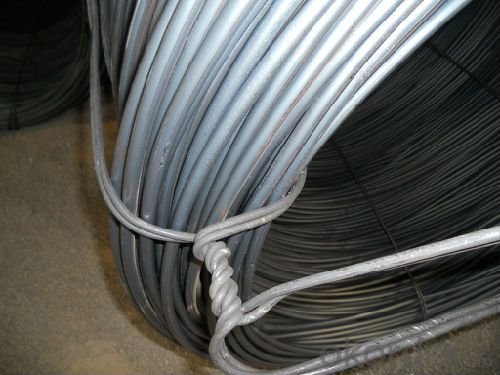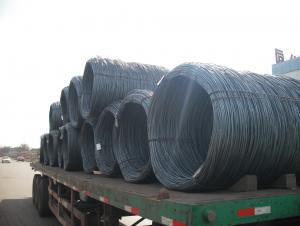High Quality Hot Rolled Carbon Steel Wire Rod
- Loading Port:
- China Main Port
- Payment Terms:
- TT or LC
- Min Order Qty:
- -
- Supply Capability:
- -
OKorder Service Pledge
OKorder Financial Service
You Might Also Like
Product Description:
OKorder is offering Wire Rod at great prices with worldwide shipping. Our supplier is a world-class manufacturer of steel, with our products utilized the world over. OKorder annually supplies products to European, North American and Asian markets. We provide quotations within 24 hours of receiving an inquiry and guarantee competitive prices.
Product Applications:
After hot-rolled the products shaped into coil and delivery as finished product, including round, square, rectangular, hexagonal and so on. Since most of the products are round, it is generally called wire rod. Carbon steel wire rod is widely used in construction and manufacturing. Carbon steel wire rod is mainly used for reinforcement of reinforced concrete and welded structure or reprocessed (roberts , nail, etc.) materials, especially used to produce wire drawing, welding electrode, nails, spring, electronic, precise machinery parts and so on.
.
Product Advantages:
OKorder's Wire Rod are durable, strong, and resist corrosion.
Main Product Features:
· Premium quality
· Prompt delivery & seaworthy packing (30 days after receiving deposit)
· Corrosion resistance
· Can be recycled and reused
· Mill test certification
· Professional Service
· Competitive pricing
Product Specifications:
Steel Grade: Q195/235, SAE1006-1018B Standard: ASTM, GB
Diameter: 5.5mm, 6.5mm, 7mm,8mm,9mm,10mm,12mm,14mm
Type: in coil, coil weight around 2MT Alloy or Not: Alloy
Surface: round, no twisted, light and smooth Chemical Composition: (Please kindly find our chemistry of our material based on Q195、Q235A and Q235B as below for your information)
Packaging & Delivery of Hot Rolled Wire Rod:
Packaging Detail: products are packed in coil, each coil weight around 2 MT, and then shipped by container or bulk vessel
Delivery Detail: within 45 days after received deposit or LC.
Label: to be specified by customer, generally, each bundle has 1-2 labels
Trade terms: FOB, CFR, CIF
FAQ:
Q1: Why buy Materials & Equipment from OKorder.com?
A1: All products offered byOKorder.com are carefully selected from China's most reliable manufacturing enterprises. Through its ISO certifications, OKorder.com adheres to the highest standards and a commitment to supply chain safety and customer satisfaction.
Q2: How do we guarantee the quality of our products?
A2: We have established an advanced quality management system which conducts strict quality tests at every step, from raw materials to the final product. At the same time, we provide extensive follow-up service assurances as required.
Q3: How soon can we receive the product after purchase?
A3: Within three days of placing an order, we will begin production. The specific shipping date is dependent upon international and government factors, but is typically 7 to 10 workdays.
Images:


- Q:How is steel wire rod used in the production of wire mesh for concrete reinforcement?
- Steel wire rod is used in the production of wire mesh for concrete reinforcement by being drawn through a series of dies to reduce its diameter and increase its length. This process, known as wire drawing, creates a strong and uniform wire that is then woven or welded into mesh sheets. The wire mesh is then placed within the concrete mixture to provide additional strength, prevent cracking, and enhance the overall structural integrity of the concrete.
- Q:What are the common production processes for low carbon steel wire rod?
- The common production processes for low carbon steel wire rod include melting and refining the raw materials, continuous casting to form billets, hot rolling the billets into wire rod coils, cooling and coiling the wire rod, and finally, surface treatment and packaging for shipment.
- Q:What are the safety standards for steel wire rod used in construction?
- The safety standards for steel wire rod used in construction vary depending on the specific application and local regulations. However, some general safety standards include ensuring the wire rod meets the required strength and quality specifications, proper storage and handling to prevent damage or injury, regular inspection for defects or signs of wear, and adherence to proper installation and usage guidelines. Additionally, safety standards may also dictate the use of personal protective equipment and training for workers involved in handling or working with steel wire rod in construction projects. It is essential to consult relevant industry guidelines and local regulations to ensure compliance with specific safety standards.
- Q:What are the common sizes of steel wire rods?
- The common sizes of steel wire rods vary depending on their intended use, but some common sizes include 5.5mm, 6.5mm, 8mm, and 10mm.
- Q:What are the different types of steel wire rod rolling processes?
- There are several different types of steel wire rod rolling processes, including hot rolling, cold rolling, and warm rolling. Each process has its own advantages and is used for specific applications. Hot rolling involves heating the steel rod and then passing it through a series of rollers to reduce its diameter and increase its length. Cold rolling, on the other hand, is performed at room temperature and results in a smoother finish and increased strength. Warm rolling is a combination of hot and cold rolling, where the steel rod is heated to a lower temperature than in hot rolling but higher than in cold rolling. This process offers a balance between strength and surface quality.
- Q:How is steel wire rod used in the manufacturing of wire rope shackles?
- Steel wire rod is used in the manufacturing of wire rope shackles as it serves as the primary raw material. The wire rod is first drawn through a series of dies to reduce its diameter and improve its strength. The resulting wire is then twisted and braided together to form the wire rope, which is then used to construct the shackles. The high strength and durability of steel wire rod make it an ideal material for ensuring the reliability and safety of wire rope shackles in various applications.
- Q:How is steel wire rod used in the manufacturing of wire for automotive seatbelts?
- Steel wire rod is used in the manufacturing of wire for automotive seatbelts as it serves as the primary raw material. The steel wire rod is first drawn through a series of dies to reduce its diameter and increase its length, resulting in a high-strength wire. This wire is then further processed to meet the specific requirements of seatbelt manufacturing, such as heat treatment for optimal strength and ductility. The end result is a durable and reliable wire that can withstand the immense forces experienced during a car accident, ensuring the safety of passengers by effectively restraining them in their seats.
- Q:What are the main properties of steel wire rod?
- The main properties of steel wire rod include high tensile strength, excellent ductility, and good corrosion resistance. It also has good thermal conductivity and is highly malleable, making it easy to shape and form. Additionally, steel wire rod has a high melting point and is often used in various applications such as construction, manufacturing, and automotive industries.
- Q:What are the different types of steel wire rod annealing atmospheres?
- The different types of steel wire rod annealing atmospheres include hydrogen, nitrogen, and endothermic gas.
- Q:What are the factors that affect the mechanical properties of steel wire rod?
- The mechanical properties of steel wire rods are influenced by several factors. 1. Composition: The chemical composition of steel, including the presence of alloying elements such as carbon, manganese, silicon, and others, determines its mechanical properties. Different compositions result in varying levels of strength, toughness, and ductility. 2. Microstructure: The microstructure of steel, including grain size and distribution, also affects its mechanical properties. Fine-grained steels generally exhibit higher strength and improved toughness compared to coarser-grained ones. Heat treatment processes can be used to control the microstructure and enhance desired properties. 3. Heat treatment: Various heat treatment processes, such as annealing, quenching, and tempering, can significantly alter the mechanical properties of steel wire rods. These processes modify the structure and hardness of the material, providing desired levels of strength, hardness, and ductility. 4. Processing conditions: The mechanical properties of steel wire rods can also be influenced by the processing conditions during manufacturing. Factors such as the temperature, rate of cooling, and deformation applied during rolling, drawing, or extrusion processes can affect the final properties. Proper control of these parameters is crucial to achieving the desired mechanical properties. 5. Surface finish: The surface condition of steel wire rods can impact their mechanical properties. A smooth and clean surface is generally preferred as it reduces the likelihood of cracks, improves fatigue resistance, and enhances overall performance. 6. Impurities and defects: The presence of impurities, such as sulfur, phosphorus, and non-metallic inclusions, can negatively impact the mechanical properties of steel wire rods. Similarly, manufacturing defects like cracks, voids, and inhomogeneities can weaken the material and reduce its strength. 7. Environmental factors: The environment in which steel wire rods are used can affect their mechanical properties. Variables such as temperature, humidity, exposure to corrosive substances, and mechanical loading conditions can all influence the material's behavior, including its strength, ductility, and corrosion resistance. In conclusion, the mechanical properties of steel wire rods are influenced by factors such as composition, microstructure, heat treatment, processing conditions, surface finish, impurities, defects, and environmental factors. Understanding and controlling these factors are crucial in producing steel wire rods with desired mechanical properties for various applications.
1. Manufacturer Overview |
|
|---|---|
| Location | |
| Year Established | |
| Annual Output Value | |
| Main Markets | |
| Company Certifications | |
2. Manufacturer Certificates |
|
|---|---|
| a) Certification Name | |
| Range | |
| Reference | |
| Validity Period | |
3. Manufacturer Capability |
|
|---|---|
| a)Trade Capacity | |
| Nearest Port | |
| Export Percentage | |
| No.of Employees in Trade Department | |
| Language Spoken: | |
| b)Factory Information | |
| Factory Size: | |
| No. of Production Lines | |
| Contract Manufacturing | |
| Product Price Range | |
Send your message to us
High Quality Hot Rolled Carbon Steel Wire Rod
- Loading Port:
- China Main Port
- Payment Terms:
- TT or LC
- Min Order Qty:
- -
- Supply Capability:
- -
OKorder Service Pledge
OKorder Financial Service
Similar products
New products
Hot products
Related keywords




























